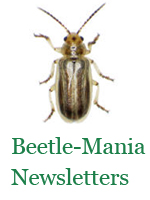Paulinia acuminata DeGeer
[Orthoptera: Pauliniidae]
Biology | History | Status | Management | Weeds | Literature | Links
This grasshopper is a native of southern Brazil. Thomas (1980) reports extensive studies on the biology of this insect. The life cycle took 38-85 days at 25-36 C. Nymphal mortality was about 50%. There were 5 or 6 nymphal instars. Estimated growth rate was 8000 per year with 3 generations (Thomas 1980).
Releases of P. acuminata were made in Kenya, Botswana Sri Lanka, Rhodesia (Lake Kariba), India, Fiji, and Queensland (Bennett 1976). It appeared to establish in Botswana but later died out (Thomas & Room 1986). Cage tests in Rhodesia and Botswana suggest that the plant growth rate could be reduced by the populations that had built up in the cages (Bennett 1976).
P. acuminata has not been very successful as a biological control agent.
This insect is of questionable value as a biological control agent for giant salvinia. The wide host range makes it unacceptable for some locations as a biological control agent.
Adults and nymphs feed on giant salvinia, water lettuce, and azolla. Adults also heavily damaged strawberries.
Bennett, F. D. 1977. Insects as Agents for Biological Control of Aquatic Weeds. Aquatic Botany 3:165-174.
Oliver, J. D. 1993. A Review of the Biology of Giant Salvinia (Salvinia molesta Mitchell). J. Aquat. Plant Manage. 31: 227-231.
Sands, D. P. A., and R. C. Kassulke. 1986. Assessment of Paulinia acuminata (Orthoptera: Acrididae) for biological control of Salvinia molesta in Australia. Entomophaga 31: 11-17.
Thomas, P. A. 1980. Life-cycle studies on Paulinia acuminata (DeGeer) (Orthoptera: Pauliniidae) with particular reference to the effects of constant temperature. Bull. Ent. Res. 70: 381-389.
Thomas, P. A., and P. M. Room. 1986. Taxonomy and control of Salvinia molesta. Nature 320: 581-584.

